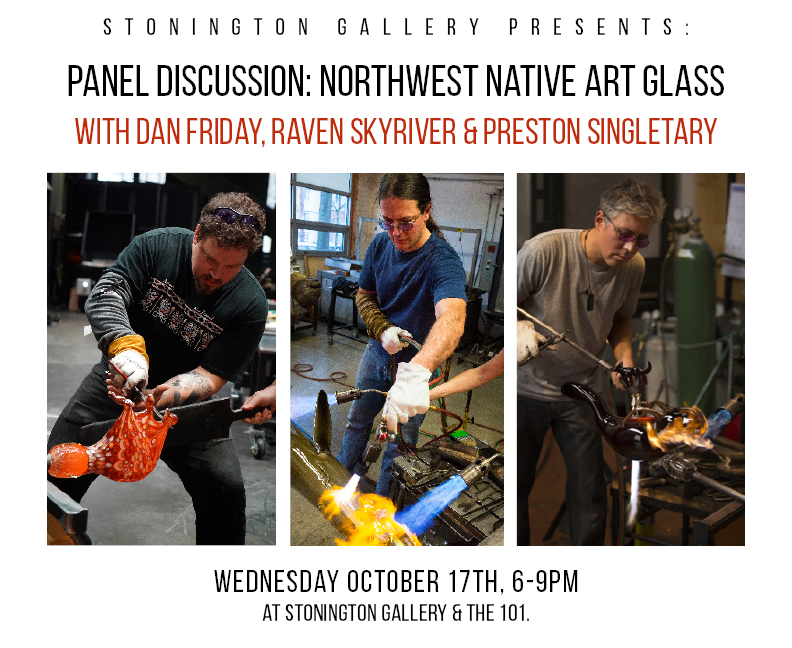October

Northwest Native Art Glass Panel Talk with Preston Singletary, Raven Skyriver and Dan Friday: Wednesday October 17th, 6-9pm.
Stonington Gallery devotes our autumn season to celebrating the Northwest Native Art Glass movement: the place where indigenous Pacific Northwest Coast art intersects with the studio glass movement. Three of the movement’s most dynamic practitioners join us for a panel discussion about Northwest Native Glass, as well as their careers and backgrounds. All three use the medium of glass to engage with and explore their Native heritage, and all from different angles: mythological, archaeological, environmental. These three have never spoken together on this subject before, and we think this is going to be one of the can’t-miss arts events of the season.
The Event:
6:00-6:30: Refreshments at Stonington Gallery. Located at 125 South Jackson Street, Seattle WA, 98104. (Optional.)
6:30: Walk one block to The 101, on the corner of Jackson and 1st Avenue.
6:45-8:15: Panel discussion and questions
8:15-9:00: Return to Stonington Gallery for dessert and artist meet-and-greet.
Join us for optional refreshments at the Stonington Gallery from 6-6:30, or meet us directly at The 101 at 6:30. The 101 is located on the same block as our gallery, and is a flat walk.
If you are driving into downtown Seattle we recommend parking at Stadium Place, which is located one block south of the gallery, and is open through 10pm. Both event venues are within five blocks of multiple bus stops, the Seattle Streetcar, and the Link Light Rail.
Tickets are $15. Purchase online at Brown Paper Tickets, or below.
Brown Paper Tickets Ticket Widget Loading…
Click Here to visit the Brown Paper Tickets event page.
About the Artists in Our Season of Northwest Native Art Glass:
September brings Dan Friday (Lummi), October is Preston Singletary (Tlingit), and in November we close with Raven Skyriver (Tlingit). All three of these artists uses the medium of glass to reflect on aspects of their vibrant Northwest Coast Native heritage, but each does so with a different focus.
Dan Friday (Lummi) is inspired by the material culture of the Lummi people: the gear with which they reefnet fish, one of the world’s oldest and most sustainable salmon-fishing techniques; the totem poles carved by his great-grandfather Joseph R. Hillaire (Kwul-kwul’t); and the cedar bark woven baskets and goat fur blankets of the great Lummi weavers. View Dan’s September exhibition here.
Preston Singletary (Tlingit) is particularly focused on mythology and legendary characters, rendering stories of the Tlingit, Haida and other northern nations in blown and sandblasted glass. Singletary transforms epic legends along the sides of bentwood boxes, on totem poles made in collaboration with carvers David Svenson (Non-Indigenous) and Dave Franklin (Non-Indigenous), and in 2d prints. View Preston’s October exhibition here.
Of the three, Raven Skyriver (Tlingit) draws deepest from the physical environment of the Pacific Northwest Coast. His incredibly life-like blown glass creatures are a celebration of the variety of aquatic and land animals of our region and beyond. He uses them to educate viewers about the ties we have to the creatures who have inhabited this land even longer than humanity, and the responsibility we owe them to keep the ecosystem healthy and sustained. View Raven’s November exhibition here.
Each exhibition in this Season of Glass has a dedicated exhibition page with works and more information. This is a general overview of the Season.

About Northwest Native Art Glass:
The Northwest’s hot love affair with glass has been smoldering for 40 years, and only grows in intensity as new artists–particularly Native artists–are drawn to the flame. Seattle has a front row seat to witness and enjoy the creation of a dynamic new art movement: Northwest Native Art Glass. It is the result of the fusion of two of the region’s most significant art genres: Native Art and Studio Glass art. The Stonington Gallery has played an important role in building the bridge between traditional Northwest Coast Native art and studio glass, and fostering the nascent scene.
Marvin Oliver (Quinault/Isleta Pueblo) and Susan Point (Musqueam) were two of the first Northwest Native artists to understand the potential of glass as a medium through which to express iconography of the Northwest Coast by sculpting, casting, fusing and etching. In the 1990s they began collaborating with glass blowers, etchers and fusers to create works that evolved what is considered “indigenous art” into a new arena.
Others were not far behind. Simultaneously, Preston Singletary (Tlingit) had mastered traditional Venetian glassblowing, but was deeply personally inspired to explore his personal artistic Tlingit legacy. Singletary immersed himself in learning the complex and challenging art tradition of 2D and 3D formline design and the stories and mythology behind crest designs. He consulted with the masters of the form, including Oliver, Duane Pasco (Non-Indigenous), Steve Brown (Non-Indigenous), Joe David (Nuu-cha-nulth), Gregg Blomberg (Non-Indigenous) and David Svenson (Non-Indigenous).
Singletary’s dedication allowed him to emerge in the mid-to-late 1990s as a visionary star of Native Glass Art. His meteoric rise to become one of the genre’s leading voices introduced glass collectors around the world to the nature of Northwest Coast formline and art, and Native art collectors to the potential of glass.
Singletary is often asked why he combines the medium of glass with Northwest Coast art, as if it were an uneasy or unorthodox pairing. He points out that glass has been on the Coast since Europeans brought glass beads for trading aboard ships. Glass was introduced centuries ago, and has been incorporated in the generations since. As master carver Joe David (Nuu-chah-nulth) has wisely observed, Native artists have always been resourceful; if you show an artist something new, they will be excited about its possibility. It is what adaptable people do; they work with their environment.
